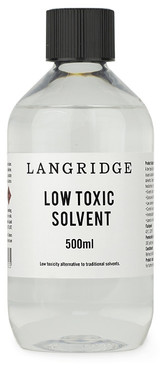
Low Toxic Underpainting Medium
Low-toxicity solvent (odourless) based Lean medium used for ‘first-sketch’ in oil painting.
Low oil content for rapid drying, minimises chances of cracking when overpainting with full strength colours.
Ensures pale colours stay bright whilst deep tones are enriched.
Constituents
Stand Oil (40 Poise), Low Toxic Solvent, Alkali Refined Linseed Oil, Cobalt Drier.
Product Application
Langridge Low Toxic Underpainting Medium may be added to oil colours in quantities at the discretion of the artist.
Initially small additions will purely aid the flow qualities of existing oil colours. As more medium is added to the oil colour, the transparency will be increased due to the further dispersion of the pigment throughout the medium.
In accordance with all Langridge Painting Mediums, Low Toxic Underpainting Medium is formulated with a proportion of oil to solvent that can be used unrestrictedly in glazes and washes without risking underbinding the pigment from the oil.
After 15 minutes under normal conditions of applying Langridge Low Toxic Underpainting Medium the surface will set-up to a tack that grabs any succeeding brush strokes. Langridge Underpainting Mediums stay wet for a much shorter period than Langridge Painting Mediums and are best employed for successive layering rather than a wet-in-wet technique.
Langridge Low Toxic Underpainting Medium has a low oil content and, as such, is a ‘lean’ medium.
It should not to be used for overpainting very fat or slow drying layers of paint.
Dries to a Satin finish.
Additional Product Information
A Low Toxic Alternative
Because Langridge Low Toxic Solvent has a Permissible Exposure Level (PEL) higher than other solvents the artists exposure will not be as harmful in comparison to traditional solvents.
Associated issues with prolonged contact with traditional artists’ solvents such as dermatitis, skin and respiratory organ irritation, headaches, etc. can be dramatically reduced or removed by using Langridge Low Toxic Solvent.
Langridge still recommends the use of good studio ventilation, open windows to increase airflow and preferably a properly installed exhaust system.
Sealing timber and other non-flexible supports
Where an absorbent non-flexible support such as wood or composite timber product (e.g. MDF) needs a penetrative sealant, Underpainting Medium can be applied by brush or rag as a thin layer. Allow to fully dry before application of paint on top.
Altering the reflective finish
The addition of Wax Painting Paste to Low Toxic Painting Medium can reduce the gloss finish normally associated with an oil paint medium. Mix together 1 part Wax Painting Paste to 4 parts Low Toxic Underpainting Medium for a satin finish. A higher proportion of wax medium may be added for extra matte effects.
The addition of Wax Painting Paste will give more body to the medium, so the artists technique should allow for this in application.
Adhesion problems
When very fluid glazes are applied on top of a layer of glossy paint in which there is a high proportion of a Langridge Medium containing Stand Oil the surface may exhibit Surface Beading. The overall adhesion of the paint Layer is unaffected however the artist may find the effect distracting or displeasing. The application of a very thin layer of Retouch Varnish to the touch dry paint surface will help to prevent the ‘beading up’ of succeeding paint layers. For more information.
To even out the final reflective quality of the painting
There are numerous reasons for an uneven reflective quality in the final paint film. Differences in the particle size of individual pigments, the various recipes of individual oil colours, the variety of oil mediums, layers and techniques employed etc. generally lead to a finished picture with a wide range of reflective finishes. Additionally, as with all petroleum distillates, Langridge Mediums made with Low Toxic Solvent have a slight tendency to dry to an uneven reflective finish.
If the surface has only minor variation, the application of Retouch Varnish once touch dry or a final picture varnish after the painting has had time to dry thoroughly (approx. 3 – 6 months) can generally unify the surface.
If the reflective disparity is highly pronounced, a picture varnish may not even the differences out. In this case the surface can easily be rectified by “oiling out” using Langridge Isolating Medium or another “Fat” medium. Oiling out is a non removable process and does not replace a removable artists’ varnish. (See…)
Thinning
For best results thin with Low Toxic Solvent. However, Artists White Spirit or Distilled Gum Turpentine may be substituted. The use of Artists White Spirit will tend to reduce the fatness of stroke and the oil film will dry with less richness due to the partial destruction of the paint film.
Appearance
Langridge Low Toxic Underpainting Medium is a pale amber coloured liquid with characteristic linseed oil odour.
Very fresh medium may exhibit a green cast. The colour of the medium will not effect the oil colours with which it is mixed.
Clean Up
Clean brushes with any artists’ solvent (eg Low Toxic Solvent, Gum Turpentine, etc.).
For further washing apply a small quantity of Marseille or other pure olive oil soap and massage the bristles of the brush to release any remaining colour. Wash thoroughly in warm water. Leave to fully dry before using for oil colours.
Drying Times
24-48 hours to touch dry. Any airflow over the surface will evaporate the solvent more rapidly which will reduce drying times.
Full film drying 3-6 months




